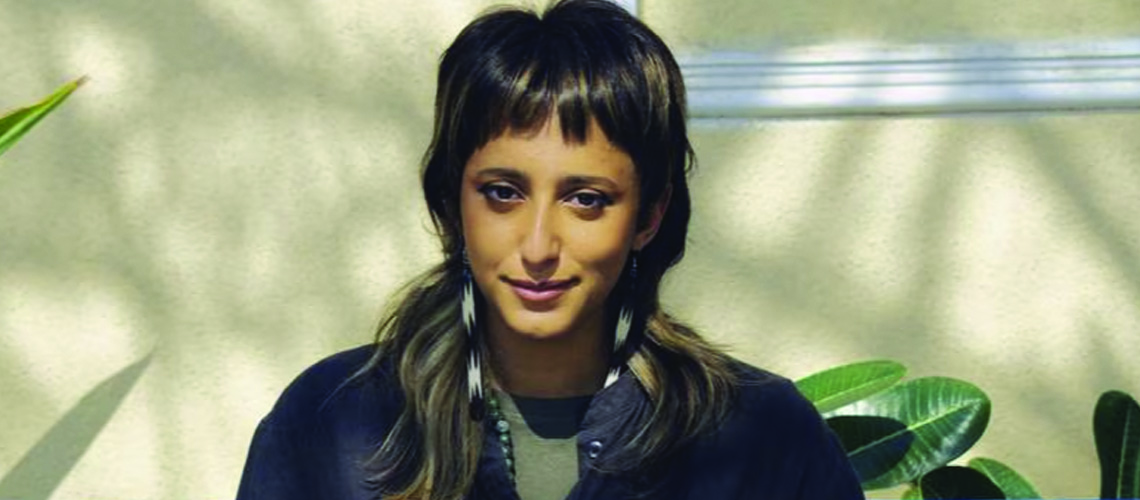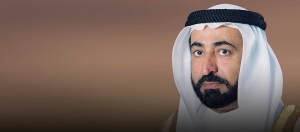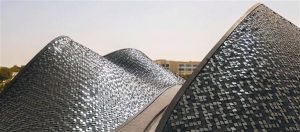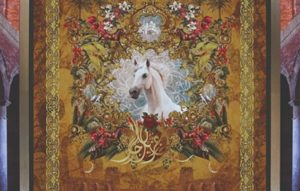Sahem exhibition is a journey into the capital’s history via her own personal stories
Almaha Jaralla’s solo exhibition at Tabari Artspace in the DIFC will feel familiar to anyone who grew up in the Gulf in the 1980s and early ’90s.
Titled Seham, the Emirati artist’s showcase is a journey into Abu Dhabi’s history via scenes of family life.
“I’m using my family to talk about periods of time in Abu Dhabi that a lot of people can relate to,” Jaralla tells The National. “I was inspired by how everyone was together at that time. As family groups, I think we lost something with social media.”
Three sets of majlis-styled sofas surround four matching glass coffee tables in the centre of the gallery, welcoming visitors into the space. On the coffee table, pressed under the glass surface, are a number of family photos – children playing on a beach, families having a picnic and a portrait of a young boy.
The sofas are ornate and vintage, upholstered in pink textured material with flower-like patterns. They are echoed on the wallpaper of the gallery, which has a slight pink sheen of its own. The works, mid to large-scale oil paintings, hang frameless on the wall and are an accumulation of the setting.
It simultaneously feels like stepping into a living room of an ’80s Arab home in the Gulf as well as a study of domestic and familial scenes.
“There was a time where you had to see people face to face to ask them about their day,” Jaralla says. “Those aspects I didn’t live through. I’m trying to conceptualise that time. I’m trying to understand the family dynamic of that time.”
:quality(70)/cloudfront-eu-central-1.images.arcpublishing.com/thenational/PF7Q2AEOOBGI5J3UUWZZXGC3AY.jpg)
Despite being born in 1996, Jaralla found herself drawn to the ’80s.
“This work is like me having a conversation with my younger dad and trying to conceptualise their time, growing up in Abu Dhabi in the ’80s. That was the inspiration of the curation,” she says.
Jaralla also brings the time period to life through colour, using palates, textures and patterns that were popular at the time. She also uses aged photographs extensively.
Jaralla’s great aunt, Seham, eagerly documented her surroundings in the ’80s with a Fuji camera.
“I wanted viewers experiencing the work to be inside of that filter by creating this light pink atmosphere,” she says. “Especially with the lights at night, it does feel like you’re inside of a pink or red filter.”
The paintings seamlessly combine pictorial ideas of flatness and space. Figures pose and sit in the space, recalling a stillness similar to the frozen silhouettes we recognise from printed photographs.
However, Jarallah’s application of paint, particularly in the background, is lush and free flowing working against the still figures in satisfying harmony.
The body of work features personal stories as well as the story of Abu Dhabi coming into its own.
One work focuses on Abu Dhabi’s Al Maqtaa Bridge, built in 1968, the first structure to connect the island to the mainland. It’s a subject that connects many of the themes Jaralla is preoccupied with – the past and present, tradition and modernity, record keeping and nostalgia.
“By understanding family dynamics and understanding my family, it gives me a better understanding of myself and how I became the person I am,” Jaralla says.
“It’s very emotional you look at these photos. You can recognise people but they just look different now and the amount of stories they have … I just want to listen to and ask them all about.”
Emirati artist Almaha Jaralla turns 1980s Abu Dhabi family life into solo show
Jaralla’s work, in a sense, is a form of record-keeping. In the same way, her great aunt was documenting everyday life at the time, through photography, Jaralla is using those records to make sense of them.
“It’s not about the people in the photos. It’s about a bigger topic,” Jaralla says.
“It’s about using family archives, stories and dynamics to talk about the modern history of the region. I’m just using my family archives as a tool to open that conversation.”
www.thenationalnews.com




